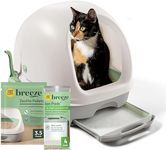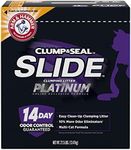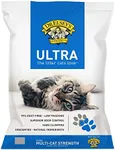Buying Guide for the Best Cat Litter For Odors
Choosing the right cat litter is crucial for maintaining a fresh-smelling home and ensuring your cat's comfort. When selecting a cat litter specifically for odor control, it's important to consider factors such as the type of litter, its odor control capabilities, clumping ability, dust levels, and the scent. Each of these factors can significantly impact how well the litter performs in controlling odors and how comfortable it is for both you and your cat. Understanding these key specifications will help you make an informed decision that suits your household's needs.Type of LitterThe type of litter refers to the material from which the litter is made. Common types include clay, silica gel, and natural/biodegradable options like corn, wheat, or pine. This spec is important because different materials have varying abilities to control odors and clump. Clay litters are popular for their clumping ability and odor control, but they can be dusty. Silica gel litters are great for absorbing moisture and controlling odors but may not clump. Natural litters are eco-friendly and often have good odor control but may not clump as well as clay. Choose a type based on your preference for clumping, dust levels, and environmental impact.
Odor ControlOdor control refers to the litter's ability to neutralize or mask the smell of cat waste. This is crucial for maintaining a pleasant environment in your home. Some litters use baking soda, activated charcoal, or other additives to enhance odor control. When evaluating odor control, consider how long the litter can effectively manage odors and whether it uses natural or chemical additives. If you have multiple cats or a small living space, you might need a litter with stronger odor control capabilities.
Clumping AbilityClumping ability is the litter's capacity to form solid clumps when it comes into contact with moisture. This is important because it makes cleaning the litter box easier and helps control odors by trapping waste. Litters with strong clumping ability are typically made from clay. If you prefer easy scooping and want to minimize odor, look for a litter that clumps well. However, if you prioritize dust-free or natural options, you might have to compromise on clumping ability.
Dust LevelsDust levels refer to the amount of dust produced when handling the litter. This is important for both your cat's respiratory health and your own, as well as for keeping your home clean. Low-dust litters are preferable, especially if you or your cat have allergies or respiratory issues. Clay litters tend to be dustier, while silica gel and some natural litters are often marketed as low-dust. Consider your household's sensitivity to dust when choosing a litter.
ScentThe scent of the litter can either be natural or added to help mask odors. This is important because a strong scent can be off-putting to both cats and humans. Some cats may be sensitive to artificial fragrances, so it's important to choose a scent that is mild or opt for unscented if your cat is sensitive. If you prefer a scented litter, ensure it's not overpowering and that your cat is comfortable using it. The right scent can enhance odor control without being overwhelming.

















